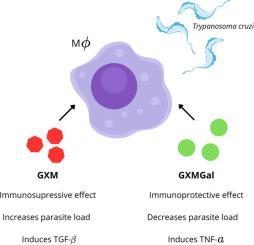新型隐球菌荚膜多糖对克氏锥虫感染巨噬细胞的免疫调节作用。
IF 2.5
3区 医学
Q2 PARASITOLOGY
引用次数: 0
摘要
新型隐球菌是一种全球分布的机会性真菌病原体,是隐球菌病的病原体,隐球菌病是一种主要影响免疫功能低下个体的疾病。感染通常从肺部开始,在严重的情况下,可以发展为脑膜脑炎甚至死亡。生化研究表明,真菌荚膜主要由葡萄糖醛酸甘露聚糖(GXM)组成,约占总成分的88%,其次是葡萄糖醛酸甘露聚糖(GXMGal,约10%)和甘露蛋白(约2%)。据报道,纯化的荚膜成分表现出明显的免疫调节作用:虽然GXM主要发挥免疫抑制活性,抑制免疫反应,但GXMGal具有免疫保护特性。为了在另一种感染模型中评估这些差异免疫调节作用,我们采用了一种体外系统,使用感染克氏锥虫DM28c菌株的小鼠巨噬细胞,然后用GXM或GXMGal治疗。我们的研究结果表明,在感染后7天和10天,即使用干扰素-γ刺激巨噬细胞,gxm处理的条件下释放的trypomastigotes数量也高于gxmg处理的条件。此外,GXM处理的巨噬细胞中,无马鞭毛体计数较高,而gxmg处理的条件下,一氧化氮的产生增加。ELISA检测细胞因子结果显示,gxmg处理的细胞中TGF-β水平升高,TNF-α水平升高。此外,抑制试验证实,用特定抑制剂治疗后,这些作用被逆转。初步的体外感染和治疗模型表明,即使在不同的感染环境下,新型荚膜成分的免疫调节作用仍然存在。这些发现强化了GXM作为免疫抑制因子和GXMGal作为免疫保护剂的作用,提示在不同的感染环境下,荚膜成分可能不同地调节宿主的免疫反应。本文章由计算机程序翻译,如有差异,请以英文原文为准。

Immunomodulatory effects of Cryptococcus neoformans capsular polysaccharides on macrophage infected with Trypanosoma cruzi
Cryptococcus neoformans is an opportunistic fungal pathogen with a global distribution and is the causative agent of cryptococcosis, a disease that primarily affects immunocompromised individuals. The infection typically begins in the lungs and, in severe cases, can progress to meningoencephalitis and even death. Biochemical studies have shown that the fungal capsule is predominantly composed of glucuronoxylomannan (GXM), which accounts for approximately 88% of the total composition, followed by glucuronoxylomannogalactan (GXMGal, ∼10%) and mannoproteins (∼2%). Purified capsular components have been reported to exhibit distinct immunomodulatory effects: while GXM predominantly exerts immunosuppressive activity, inhibiting immune responses, GXMGal has been associated with immunoprotective properties.
To evaluate these differential immunomodulatory effects in another infection model, we employed an in vitro system using murine macrophages infected with the Trypanosoma cruzi DM28c strain, followed by treatment with either GXM or GXMGal. Our results demonstrated that at 7 and 10 days post-infection, the number of trypomastigotes released was higher in GXM-treated conditions compared to GXMGal-treated conditions, even when macrophages were stimulated with interferon-γ. Additionally, amastigote counts were higher in macrophages treated with GXM, whereas GXMGal-treated conditions showed increased nitric oxide production. Cytokine quantification by ELISA revealed elevated TGF-β levels in GXM-treated cells and increased TNF-α levels in GXMGal-treated conditions. Furthermore, inhibition assays confirmed that these effects were reversed upon treatment with specific inhibitors.
The preliminary in vitro infection and treatment model indicates that the immunomodulatory effects of C. neoformans capsular components persist even in a distinct infection setting.
These findings reinforce the role of GXM as an immunosuppressive factor and GXMGal as an immunoprotective agent, suggesting that capsular components may differentially modulate host immune responses in various infectious contexts.
求助全文
通过发布文献求助,成功后即可免费获取论文全文。
去求助
来源期刊

Acta tropica
医学-寄生虫学
CiteScore
5.40
自引率
11.10%
发文量
383
审稿时长
37 days
期刊介绍:
Acta Tropica, is an international journal on infectious diseases that covers public health sciences and biomedical research with particular emphasis on topics relevant to human and animal health in the tropics and the subtropics.
 求助内容:
求助内容: 应助结果提醒方式:
应助结果提醒方式:


